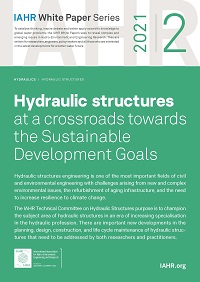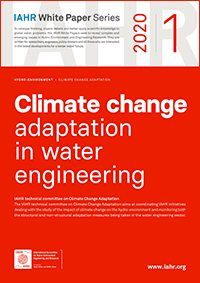IAHR White Paper Series
#iahrWhitePapers
To catalyse thinking, inspire debate and better apply scientific knowledge to global water problems, the IAHR White Papers seek to reveal complex and emerging issues in Hydro-Environment and Engineering Research. They are written for researchers, engineers, policy-makers and all those who are interested in the latest for a better water future.
Editor
Dr Angelos N. Findikakis, Bechtel Fellow, Bechtel Corporation; Adjunct Professor, Stanford University, United States of America.
Issue 1/2023 | The role of hydraulic engineering in support of flood mitigation and resilience
By Stefan Haun, Daniela Molinari, Marian Muste and Benjamin Dewals
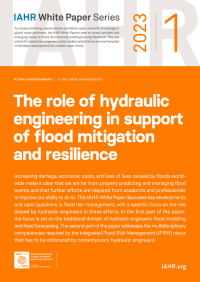 Over the last several decades, global flood events have resulted in human suffering, economic costs and damage to cultural and environmental heritage. The changing climate, transformations of rural landscapes and unsustainable urban population growth will lead to an even further increase in many regions of the world. Although experts from academia, together with professionals, are increasing knowledge on the causes and consequences of flood events, we are still far away from managing floods properly.
Over the last several decades, global flood events have resulted in human suffering, economic costs and damage to cultural and environmental heritage. The changing climate, transformations of rural landscapes and unsustainable urban population growth will lead to an even further increase in many regions of the world. Although experts from academia, together with professionals, are increasing knowledge on the causes and consequences of flood events, we are still far away from managing floods properly.
A major reason is that traditional approaches in flood management focus mainly on a hazard-centered perspective and avoiding flooding through mainly hydraulic structures. Integrated Flood Risk Management (IFRM) is a more comprehensive approach compared to this traditional pathway. IFRM shifts away from isolated and short-term solutions towards a risk management framework, which ensures flood mitigation in a holistic, transparent manner.
This White Paper provides an overview of principles and ongoing developments in IFRM. Special focus is thereby set on the future role of hydraulic engineers in flood risk management, ensuring sustainable flood risk mitigation planning and implementation in the future.
Issue 2/2021 | Hydraulic structures at a crossroads towards the Sustainable Development Goals
By Stefan Felder, Sebastien Erpicum, Sean Mulligan, Daniel Valero, David Zhu and Brian Crookston
Hydraulic structures have supported the development of societies for millennia and continue to be an integral part of global water infrastructure. Engineering of these important pieces of water infrastructure requires a specialised understanding of how water interacts with the structure to ensure maximum safety and functionality. With sustainability at the fore of the global water agenda, the value available from integrating sustainable designs in hydraulic infrastructure must not be overlooked, given their significance in creating long term, multifaceted positive impacts on society.
As humankind aims to create more sustainable and just societies, hydraulic structures will therefore have a role to play. With the endeavour to achieve the Sustainable Development Goals (SDGs) at the fore of global discussion, hydraulic structures engineers have the skills to provide technical solutions which can make a profound positive contribution to many of the SDGs.
In the past, the design and construction of hydraulic structures has been largely dominated by performance and cost considerations. This white paper argues that hydraulic structures engineers must now embrace a broader vision for the future with more environmentally friendly and socially conscious considerations. At this crossroad on the evolution of the hydraulic structures discipline, this white paper identifies essential elements of sustainability that hydraulic structures engineers may contribute to the SDGs.
Issue 1/2021 | Pathways towards democratization of hydro-environment observations and data
 Water-related problems affect several billion people’s lives and represent an annual challenge assessed at multitrillion US dollars, which substantiates their core role in the UN Sustainable Development Goals. Preventing direct and indirect impacts associated with water excess or water scarcity events requires expert judgement based on reliable information. Therefore, observations and measurements are fundamental prerequisites for making scientific progress.
Water-related problems affect several billion people’s lives and represent an annual challenge assessed at multitrillion US dollars, which substantiates their core role in the UN Sustainable Development Goals. Preventing direct and indirect impacts associated with water excess or water scarcity events requires expert judgement based on reliable information. Therefore, observations and measurements are fundamental prerequisites for making scientific progress.
The current policy trend towards open-science (open-data repositories, open-software communities, open-access publications), is an opportunity for data democratization. However, it must be affordable and sustained by trusted researchers and scientific institutions in order for it to become a real instrument of progress towards common access. Furthermore, the easy access to information may contribute to the false perception of assurance. Experts capable of interpreting the data and aware of their limitations, should always be involved to avoid ill-informed governance and policy-making processes.
In this new IAHR white paper, a broad spectrum of experts from different backgrounds guided by the focus of the IAHR technical committee on Experimental Methods and Instrumentation provides a community vision on future pathways aimed at leveraging conventional and emerging methods to facilitate access to hydro-environment observations.
Issue 1/2020 | Climate change adaptation in water engineering
By Roberto Ranzi
The community of professionals, stakeholders and end-users in the water engineering sector is concerned about the observed and projected impact of global warming and related changes on the water cycle. Little doubt exists about the fact that the observed global temperature increase is already impacting some components of the hydrosphere, the most evident one being the cryosphere with the retreat of ice masses.
We must rethink our approach to designing hydraulic structures and managing water resources in the most climate-sensitive environments, such as coasts and islands, mountain areas, rapidly developing mega-cities, and high-latitude tundra with permafrost. At the same time, we need to strengthen our scientific efforts in monitoring and understanding the impact of global warming on the water systems.
In this white paper, Roberto Ranzi, Professor of Hydraulic structures and River basin monitoring and restoration at the University of Brescia, Italy, and chair of the IAHR technical committee on Climate Change Adaptation, addresses some of the key approaches and challenges associated with climate change adaptation in water engineering.
ISSN (Print): 2664-5329 ISSN (Online): 2664-5637
Issue 1/2019 | Artificial Intelligence. How can water planning and management benefit from it?
By Dragan Savic
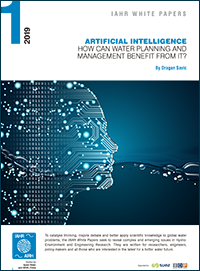 Lately, it appears that our society has become fixated on the topic of Artificial Intelligence (AI), with opinions often ranging from one extreme to the other – either how AI could solve a range of current and future world problems, or how it could potentially be very dangerous to humankind. But do we really understand what AI is, how it relates to human intelligence and how/where it most likely could be deployed by the hydro-environment community for the betterment of the environment and advancement of society? This white paper addresses some of these questions and provides a brief introduction to the topic of AI and Machine Learning, together with some example applications in water management practice.
Lately, it appears that our society has become fixated on the topic of Artificial Intelligence (AI), with opinions often ranging from one extreme to the other – either how AI could solve a range of current and future world problems, or how it could potentially be very dangerous to humankind. But do we really understand what AI is, how it relates to human intelligence and how/where it most likely could be deployed by the hydro-environment community for the betterment of the environment and advancement of society? This white paper addresses some of these questions and provides a brief introduction to the topic of AI and Machine Learning, together with some example applications in water management practice.
Professor Dragan Savic, Fellow of the Royal Academy of Engineering, is the CEO of KWR Water Research Institute, the Dutch drinking water companies’ collective research organization. He is also the United Kingdom’s first professor of Hydroinformatics, having held this position at the University of Exeter since 2001. His research interests cover the interdisciplinary field of Hydroinformatics, which transcends traditional boundaries of water/environmental science and engineering, informatics/computer science (including Artificial Intelligence, data mining and optimization techniques) and environmental engineering. Professor Savic has served as both the chair of the of the IAHR/IWA joint technical committee on Hydroinformatics and as the editor in chief of the Journal of Hydroinformatics.
ISSN (Print): 2664-5329 ISSN (Online): 2664-5637
The role of engineers in the effort to achieve SDG 6. A White Paper
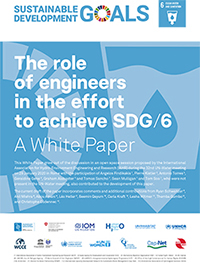 The purpose of this white paper is to provide an overview of the contribution of engineering to the effort to achieve the water-related Sustainable Development Goals (SDGs) of Agenda 2030 and to discuss what more engineers should be doing, including expanding their horizons beyond the confines of their traditional engineering education and the importance of embracing a human rights-based approach. In addition, it explores how the modern paradigm of engineering, which inherently integrates nature-based approaches, contributes and enables national stakeholders to achieve the SDGs through gender-responsive, human rights-based approaches.
The purpose of this white paper is to provide an overview of the contribution of engineering to the effort to achieve the water-related Sustainable Development Goals (SDGs) of Agenda 2030 and to discuss what more engineers should be doing, including expanding their horizons beyond the confines of their traditional engineering education and the importance of embracing a human rights-based approach. In addition, it explores how the modern paradigm of engineering, which inherently integrates nature-based approaches, contributes and enables national stakeholders to achieve the SDGs through gender-responsive, human rights-based approaches.
The white paper grew out of the discussion in an open space session proposed by IAHR during the 32nd UN-Water meeting on 29 January 2020 in Rome and is the result of a collaborative effort by representatives of IAHR, the Swiss Agency for Development and Cooperation (SDC), the International Organization for Migration (IOM), Human Right 2 Water, UN-Habitat, the UN Refugee Agency (UNCHR), the World Council of Civil Engineers (WCCE), UNESCO’s Intergovernmental Hydrological Programme (IHP), the Office of the High Commissioner for Human Rights (OHCHR), UN Women, the Women for Water Partnership (WfWP), the International Capacity Development Network for Sustainable Water Management (Cap-Net), and the International Association of Hydrological Sciences (IAHS).
